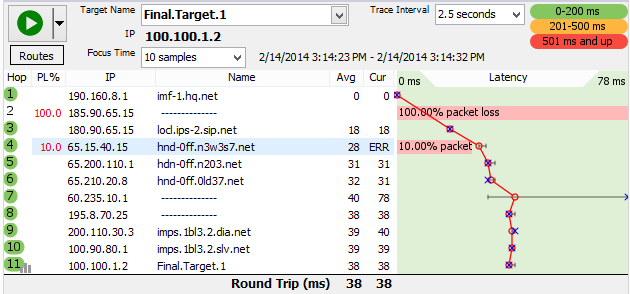Knowledge Base
Blank / missing hop (Router)
Question
Why do I sometimes see blank lines in the graph display? There's a hop number but no IP address, etc. listed.
Solution
The absence of an IP address (and 100% packet loss) for a specific hop means that no router has responded for that hop. This happens on occasion when a router is configured to not respond to TTL=0 ICMP echo requests. This is not entirely
The really important point to know about these routers is that if they are not affecting the downstream hops, then their behavior should be considered "normal".
Here are a couple of examples:
Let's say you have a pretty good looking route, but 100% packet loss at hop 2. Hop 3 is showing 0% loss, and so are other hops all the way to your final destination. The latency increases gradually as you get further downstream, but except for the 100% packet loss at hop 2, everything looks pretty good.
This is a situation where there is no problem! All packets are moving through hop 2 on their way to the downstream routers, so the fact that hop 3 (and hop 4, 5, etc) is responding means that hop 2 is working fine, just not responding to ICMP echo requests.
Another example: You're seeing 75% packet loss at hop 5, but 0% packet loss at hops 6 and 7, but 15% packet loss at hop 8, 9, and 10 (the final destination).
In this case, there is probably a problem (because the final destination is getting 15% packet loss), but the problem isn't at
Here is an example of a graph with both a 100% packet loss hop (hop 2) and a high packet loss hop that is responding (hop 4):

This is actually a great-looking trace. See how solid the final destination is? No packet loss, solid latency. The packet loss at hop 4 is not adding latency or packet loss downstream, and the non-responsive hop 2 is just a configuration on that router - it's not affecting the final destination negatively at all.
For more information and analysis, see our VoIP troubleshooting guide which talks in depth about the analysis of this graph and others.
Something to note here is that the moment a router *does* respond on that hop, Ping Plotter will record that information, so whenever you have a blank line, that means that no router has responded at all.
A very important thing to remember is that the only thing that really matters is the final destination. If the final hop is showing 0% packet loss and acceptable latency, then all the hops before that can show all kinds of errors and as long as the final destination isn't affected, then this is an artifact of router configuration, and there is no problem.
Also, an important thing to remember is that any hop (including the final destination) might be showing packet loss with PingPlotter, but might be working fine with your intended applications (ie: web browser, or game). Your best bet in convincing someone there is a problem is to correlate PingPlotter data with other symptoms (ie: online game performance problems, timing out web pages, lagging stock quotes, etc.). The only thing that really matters is the performance of the applications you're running - PingPlotter helps put some numerical data behind the symptoms you're seeing, but getting good PingPlotter performance isn't your end goal.

